Dream Come True
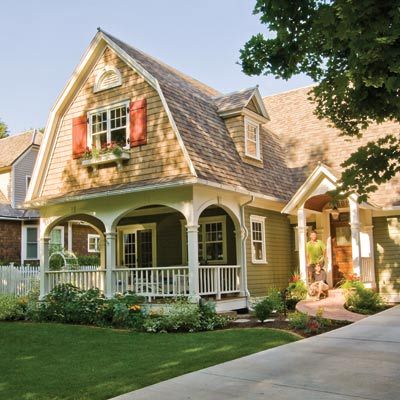
Chills ran up my arms while I watched the crew roll my beautiful old home, creaking and groaning, off its crumbling stacked-sandstone foundation and onto rails set up in the side yard. I knew we had to pour a concrete foundation to save the 1901 house, but that didn’t mean I had to like it. A few nerve-racking hours later, it was safe and sound on its temporary resting place. What a relief! My husband, Dennis, who has decades of home-building experience, had planned everything out to the inch, so I should have known he and the crew would get it right, but it was a scary ordeal. After all, this wonderful old house was my dream come true, and I really didn’t like seeing it perched perilously off the ground.
See, for years I routed my morning walks through the historic district of our mountain town of Bozeman, Montana, imagining what the interiors of the 19th- and 20th-century homes must be like. While visions of my very own old bungalow danced in my head, I never really believed I could talk Dennis into the idea of “rectifying someone else’s mistakes,” as he puts it. But after 23 moves during his 29-year career, he promised the next move would be my choice. I jumped at the offer, dragging him off to tour several old houses on the market.
Shown: The renovated Dutch Colonial Revival’s red shutters pop against new cedar shingles. Porch railings and a portico entry mimic the home’s original woodwork.
Humble 1898 Beginnings
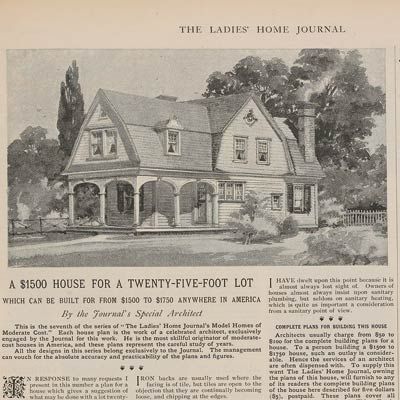
And when we saw this Dutch Colonial Revival, we knew it had just the right potential. Outside, the home had a gambrel roof and unique front porch arches, still intact. Inside, while much had been stripped away over time, some bits of character, like push-button light switches, remained. I also loved the house’s history. It was built for an enterprising female music professor at the turn of the century from a $5 architectural plan from Ladies’ Home Journal. She financed it with music lesson fees.
Shown: The homeowners found this 1898 Ladies’ Home Journal ad offering the plans for their house. Cost to build it at the time: $1,500 to $1,750.
Old Houses Come with Problems
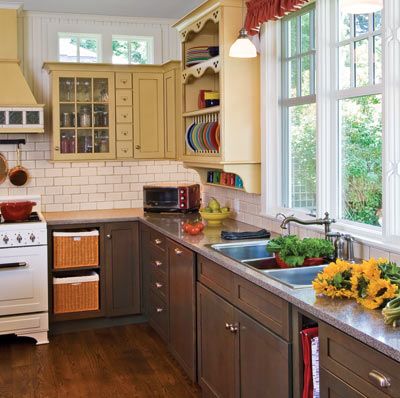
As with any old house, it had some problems. Several families had occupied the home, and it showed: Porches were enclosed, picture windows had been added, and a spray-on cottage-cheeselike preservative sold by Sears in the early 1970s encased the cedar lap siding and had cracks running through it. Interior trim had also been altered, and most of the solid five-panel doors had been cut to fit wall-to-wall carpet. In short, it needed lots of work.
The house had 1,440 square feet of living space plus a large front porch, but it lacked some modern-day conveniences, namely a home office, laundry room, and crafts area. Since the property covered three city lots, we decided to add on. While we couldn’t be purists, we wanted to make every new detail look as old as possible.
Shown: With its beadboard ceiling, subway tile, and wood floor, the colorful kitchen pays homage to the 1920s.
A Year Wait Before Renovation
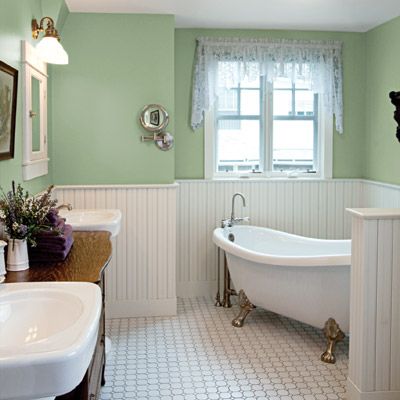
From the beginning Dennis and I jumped into researching ways to add historically appropriate charm to the place. We collected sticky-noted stacks of magazines for reference, tearing out the photos we really liked. I already knew I wanted to turn an upstairs nursery into a walk-in closet and master bath with two pedestal sinks, a claw-foot tub, and sage-green walls—just like one I had seen in the September 2003 issue of This Old House. But we waited and lived in the house for a year before deciding how big a remodel we wanted to take on. Good thing, too. Over that time we fully experienced the house’s inadequate insulation, questionable wiring, ancient plumbing—and, yes, the crumbling foundation, which had left the floors crooked and had to be replaced.
Shown: A claw-foot slipper tub is nestled into a corner of the new master bath.
Historical Exceptions for Convenience
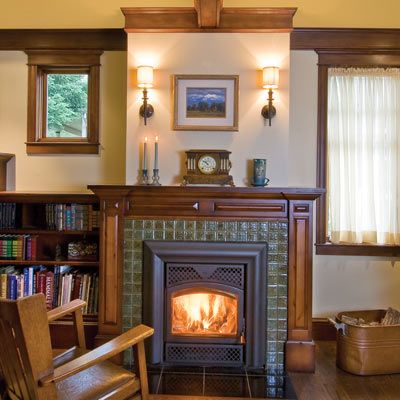
We decided to take time away from our custom-home-building business, where we both manage projects, to make the remodel our full-time job. We meticulously drew up floor plans and spec sheets, keeping energy efficiency in mind as a top priority. That meant adding sprayed urethane insulation, radiant heat, double-pane windows, and low-flow toilets. On the first floor we also decided to add a portico entry and a powder room and to open the kitchen to the dining and living rooms. That last decision wasn’t historically correct, but it fit our lifestyle and allowed us to use the original parlor chimney chase to add a centrally located fireplace.
Shown: A handsome fireplace warms up the living room. The mahogany mantel and ceramic tile surround were based on features found in neighboring houses and handcrafted by local artisans. The folding rocker traveled by covered wagon to Nebraska with Debbie’s great-grandmother.
A Wrench in the Plans
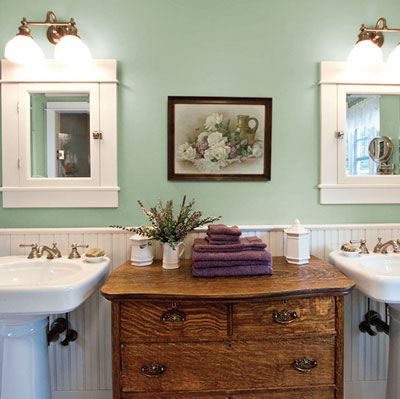
Having been so deliberate with our planning, we thought we had prepared for everything, but the house, of course, still had a few surprises in store. While preparing it to be moved, we found asbestos in the attic and the attached walls of a lean-to shed; removing it was a hurdle we knew could be dealt with only by professionals. Luckily we were able to get the men in white suits there within two weeks. It’s a bit strange, I have to say, to see your home turned into a hazmat zone, complete with a little tent outside for showering.
After that, Dennis and I immediately started gutting the house’s interior while it sat in the side yard. We had agreed in the beginning to take on the demo, but I really didn’t know what I was getting into. It was hot, muggy work, and I hated wearing a respirator. I also wasn’t too fond of having to pluck out hundreds of nails from the original fir floors, which we discovered after tearing off a layer of new oak that had been laid over them. I spent a good week crawling across the first floor with a crowbar, green knee pads strapped on. Thankfully, Dennis took care of most of the heavy hauling, while I scooped debris into buckets.
Shown: An antique oak dresser sits between two pedestal sinks, providing storage for toiletries and extra towels.
Living in the Garage
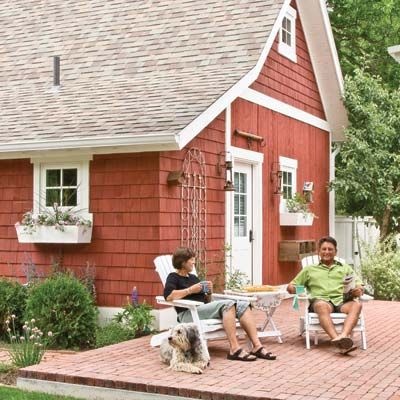
We tried to reuse, sell, or give away as much as possible, since neither of us cared to see good materials waste away in a landfill. The offer of “free” garnered some help removing the carport, patio cover, and awnings. Dennis also lugged several pallets’ worth of sandstone slabs from the old foundation to recycle in the new basement’s window wells. In the end we dragged out eight tons of lath, plaster, drywall, wiring, and plumbing pipes. Finally, with that done and the new foundation in place, we celebrated the house’s return to its original location.
It was a short-lived party, though, as we had to get started on the addition. For months we had been living in a barn-style detached garage we had built in the backyard before starting the main house’s remodel. While the 22-by-24-foot structure held our essentials—bed, desk, table, and makeshift kitchen—life there was getting claustrophobic. We had put in a half-bath, but Dennis and I had to make daily treks to the local gym to shower. And while we managed to steam vegetables on a hot plate and heat up most meals in the microwave, I was looking forward to having the use of a full kitchen again. Dennis was also eager to show that he could do all the framing carpentry and siding himself. Of course, obtaining several new top-quality power tools was a necessary first priority!
Shown: The couple takes a well-earned rest. The paver patio sits behind the barn-style garage, where the couple lived during the remodel.
Consuming Projects
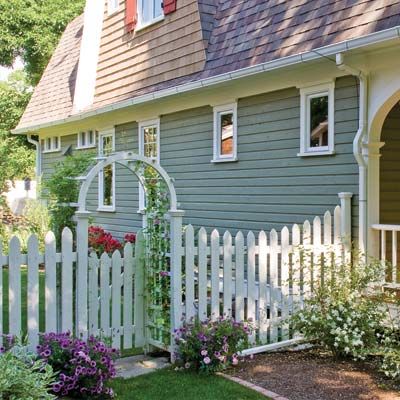
Dennis built new gambrel-shaped trusses on-site and put up custom-milled interior trim and paneling. Together, we installed new oak plank flooring. I, meanwhile, spent hours doing online research and reaching out to local suppliers to find the Heartland appliances for our 1920s-style kitchen and the right moldings to dress up the living room. This was the fun part that made all that nasty demo work worth it! As the projects consumed our days and nights, we decided to leave the interior painting and staining to professionals.
Just about 16 months after this whole process started, we were finally able to take our belongings out of storage. Remodeling this place turned out to be a lot harder than I had first imagined, but being able to surround yourself with the fruits of your labor is rewarding -beyond description. We officially plan to grow old in this home. No more moves. All the old packing boxes have gone to recycling.
Shown: Old-fashioned hydrangeas, dogwoods, roses, and lilacs surround the porch and new picket fence. A gated garden arch now leads to the backyard.
Floor Plan: First Floor
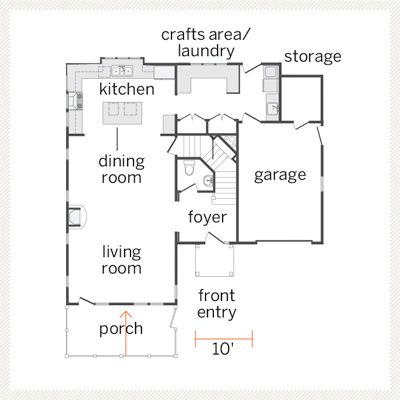
Adding on to the side of the house provided room for a new crafts area, laundry, and office.
Floor Plan: Second Floor
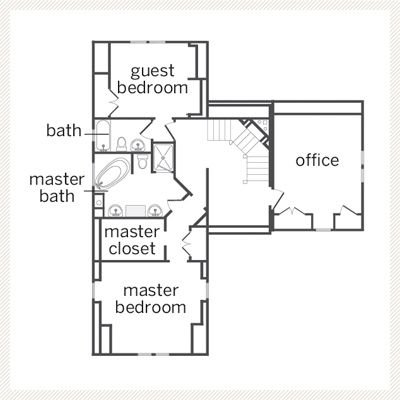
Homeowner tip: “Organize pages torn from magazines in three-ring binders tabbed by subject. That way you’ll know where to find them and what you wanted to replicate.” —Dennis Stoner, Bozeman, Mont.
What We Did: Time and Money Spent
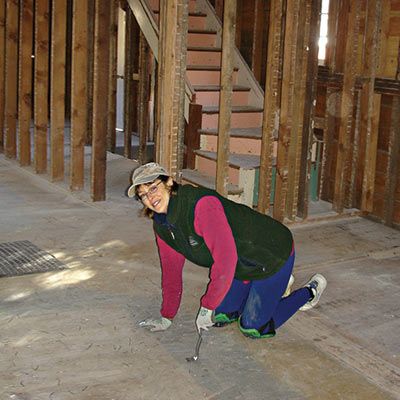
Renovated and enlarged a 1901 Dutch Colonial Revival.
Time frame: 16 months
Where we saved: Recycling as much of the old building materials as possible, such as reusing foundation stone in the basement window wells.
Where we splurged: Reproduction plumbing fixtures, like the vintage tub with silver-painted claw-feet, and lighting.
Shown: Homeowner Debbie Stoner prying nails out of the home’s original floors.
What We Did: Challenges
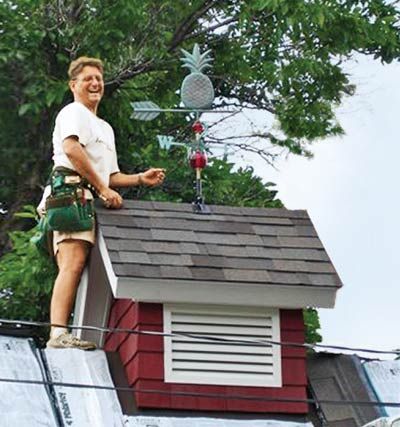
What we would do differently: Nothing! I think we did everything pretty much the way we needed to.
Our biggest challenge: Keeping our health, safety, and sanity during such a big project.
How we solved it: By building a small storage barn with a half-bath first so that we could camp out there during the remodel.
Shown: Homeowner Dennis Stoner installing the weather vane on the new garage.
